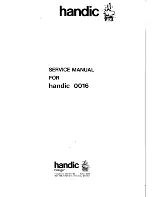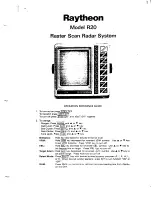
39
perform sounding by pressing the corresponding key at each point. When finished,
press
Esc
or the
Stop
button.
Mode
(for
Zond-12e
GPR family only)
-
it has three modes:
Sounding,
Test
and
Calibration
. The first one is the sounding mode. The rest two modes are used to
test the internal modules of the control unit without any connected antennas.
Tx/Rx cables
(for single channel
Zond-12e
GPR only) – it has two options:
Combined
or
Separated
, and indicates the state of connected antenna cable, is it
contains both transmitting and receiving wires (
Combined
) or they are
Separated
.
This parameter is always automatically defined as
Separated
and cannot be
changed for 38-75-150 MHz dipole antenna. Other antennas have possibility to use
it with different options.
Channels mode
(for
Zond-12e
Double channel or Advanced control units only) –
there are four (
Zond-12e
Double channel) or six (
Zond-12e
Advanced) possible
modes:
o
Channel 1
– single channel mode for operation with single antenna connected to
channel 1.
o
Channel 2
– single channel mode for operation with single antenna connected to
channel 2.
o
Two channels
– double channel mode of operation with two antennas at the
same time connected to channels 1 and 2 in parallel mode.
o
Tx-1, Rx-2
– single channel mode when transmitting (Tx) antenna connected to
channel 1 and receiving (Rx) antenna connected to channel 2. This mode is
designed for Common Depth Point (CDP) operation and for 38-75-150 MHz
dipole antenna.
o
Tx-2, Rx-1
(for
Zond-12e
Advanced only) – single channel mode when Tx-
antenna connected to channel 2 and Rx-antenna connected to channel 1.
o
Circle mode
(for
Zond-12e
Advanced only) – modes are changing continuously
in row: Channel 1; Channel 2; Tx-1, Rx-2; Tx-2, Rx-1.
Antenna
– the supported antennas list, user should choose the proper antenna used
for sounding.
The time range is one of the most important parameters and has to be chosen very
carefully. There is a range of values. Please follow the software recommendations
while time range tuning. If you set it too high, the following warning appears:
Warning! Too small sampling rate!
But if it is too small then software reports:
Sampling rate is some redundant
. Each time range has the calculated recalculated
depth value (in meters) for the selected medium without attenuation. But in reality,
the maximum sounding depth depend on the sounding signal attenuation in the
medium. Each medium has its own attenuation level. Therefore, it is not
recommended to set time range more than it is needed to solve your task. The
principle of time range choice depends on the GPR type:
o
Range
(for
Zond-12e
GPR family and
Python-3
GPR) – the time range is
assigned for the whole trace and doesn’t depend on its number of samples. The
user can choose the
Customized
value and software automatically selects the
closest satisfying time range and aligns it to
Customized
one.
o
Range per sample
(for
zGPR
family) – the time range is assigned per sample in
the trace, where, whole time range depends on the number of samples per trace.
For example, if 0.5 ns is selected on 1024 samples, then the full trace time range
will be 512 ns; and at 0.714 ns for 512 samples corresponds to 366 ns per trace,
















































